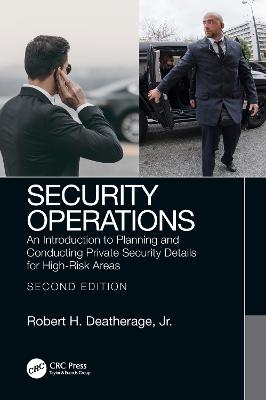
Security Operations
CRC Press (Verlag)
978-0-367-68836-3 (ISBN)
Security Operations: An Introduction to Planning and Conducting Private Security Details for High-Risk Areas, Second Edition was written for one primary purpose: to keep people alive by introducing them to private security detail tactics and techniques. The book provides an understanding of the basic concepts and rules that need to be followed in protective services, including what comprises good security practice. This second edition is fully updated to include new case scenarios, threat vectors, and new ambush ploys and attack tactics used by opportunistic predators and seasoned threat actors with ever-advanced, sophisticated schemes.
Security has always been a necessity for conducting business operations in both low- and high-risk situations, regardless of the threat level in the operating environment. Overseas, those with new ideas or businesses can frequently be targets for both political and criminal threat agents intent on doing harm. Even in the United States, people become targets because of positions held, publicity, politics, economics, or other issues that cause unwanted attention to a person, their family, or business operations.
Security Operations, Second Edition provides an introduction to what duties a security detail should perform and how to effectively carry out those duties. The book can be used by a person traveling with a single bodyguard or someone being moved by a full security detail.
FEATURES
• Identifies what can pose a threat, how to recognize threats, and where threats are most likely to be encountered
• Presents individuals and companies with the security and preparedness tools to protect themselves when operating in various environments, especially in high-risk regions
• Provides an understanding of operational security when in transit: to vary route selection and keep destinations and movement plans out of the public view
• Outlines the tools and techniques needed for people to become security conscious and situationally aware for their own safety and the safety of those close to them
An equal help to those just entering the protection business or people and companies that are considering hiring a security detail, Security Operations is a thorough, detailed, and responsible approach to this serious and often high-risk field.
Robert H. Deatherage Jr. is a veteran Special Forces Soldier and private security consultant with thirty years’ experience in military and private security operations. His various writings on security topics cover security operations, threat assessment, risk management, client relations, surveillance detection, counter surveillance operations, foot and vehicle movements, and building security—blending solid operational theory with practical field experience.
Robert H. Deatherage, Jr. is a private security consultant and security professional with a career spanning over three decades. This includes a 24-year career in the US Marine Corps and US Army Special Operations with extensive Special Forces experience in communications, operations, intelligence, and anti/counter-terrorism including conducting/managing high-risk training and design, development, implementation/ presentation of lesson plans/materials, and instructional process management for the Antiterrorism Training Detachment, US Army Special Warfare Center and School. Bob retired as the Non-Commissioned Officer In-Charge of the Antiterrorism Training Detachment, JFK Special Warfare Center and School. In this, he was responsible for training members of all U.S. Government agencies in Antiterrorism tactics, techniques and procedures to include anti-terrorism, defensive driving, threat, risk and vulnerability assessments with mitigation, physical security, surveillance detection, individual protective measures and other principals designed to increase the safety and security of US Personnel and installations operating in all environments. Bob is a Certified Antiterrorism Force Protection officer Levels II and III with experience in leading, and developing, Security/Safety plans, procedures, and their successful implementation. He has led and overseen installation, operations and maintenance of physical security devices, integration of physical and cyber security, tactical response, and personnel safety in various industries that include Commercial Nuclear Power, New Nuclear power construction, Natural gas power plants, power transmission and distribution projects, and other infrastructure projects in multiple countries, including the United States. Bob is an experienced intelligence collector and analyst for both signals and all source collection efforts in all operational environments worldwide. This in addition to being a published author on security subjects including Survival Driving, Security Operations, Terrorism Awareness. He holds a Master of Arts degree in Business and Organizational Security Management.
ACKNOWLEDGEMENTS
AUTHOR
INTRODUCTION
CHAPTER 1 WHY USE A PSC PROVIDER
CHAPTER 2 PROVIDING PROTECTION
Protection Strategies
Roles of a Protection Specialist
CHAPTER 3 THE CLIENT
Who Is the Client?
Ethical Considerations
CHAPTER 4 SECURITY ON A BUDGET
CHAPTER 5 COMPONENTS OF PROTECTION
The Bodyguard (BG)
Advance Work
The Personal Security Detail (PSD)
The Close Protection Team
CHAPTER 6 COMPOSITION OF THE SECURITY DETAIL AND THEIR RESPONSIBILITIES
Terms and Definitions
CHAPTER 7 KNOWING THE THREAT
Where Does the Treat to Us and Our Clients Come From?
Range of Threats
Internal Considerations
External Considerations
Needs Of The Threat
CHAPTER 8 RISK MANAGEMENT
Risk Assessment and Reduction
Threat Assessments
Vulnerability Assessment
Risk Assessment (Combining It All)
CHAPTER 9 THE ADVANCE
Responsibilities Of The Advance
Pre-advance Work
Location
Keys to Successful Advance Work
CHAPTER 10 SURVEILLANCE DETECTION PROGRAM
Types Of Surveillance
Methods Of Surveillance
Anti-Surveillance Techniques
Counter Surveillance
Setting Up Counter Surveillance
CHAPTER 11 AWARENESS LEVELS FOR THE SECURITY PROFESSIONAL
CHAPTER 12 SITUATION AWARENESS
Tactical Mindset
CHAPTER 13 GENERAL GUIDELINES FOR PSD OPERATIONS
CHAPTER 14 FOOT MOVEMENT TACTICS AND TECHNIQUES
One-Man Detail
Two-Man Formation
Five-Man Formation (Modified Diamond)
Five-Man Formation (Modified V)
Six-Man Formation (Diamond)
Foot Detail (Open)
Foot Detail (Close)
The Security Detail’s Mission
CHAPTER 15 PUBLIC VENUES AND FUNCTIONS
Public Speaking Venues
Reception Lines
Entering Elevators and Other Enclosed Spaces
Security Setup for Approaching an Elevator
Security Setup for Entering an Elevator
Security Setup Inside an Elevator
CHAPTER 16 ROUTE SELECTION
Route-Planning Principles
CHAPTER 17 THE PHASES OF ROUTE PLANNING
Selection of the Route
Organizing The Movement
Hostile Environments or Warzones
CHAPTER 18 MOVING THE CLIENT
Identify the Routes
CHAPTER 19 MOTORCADE OPERATIONS
Terms and Definitions
Vehicle Embus And Debus Procedures
Reacting To An Attack While Moving
Choosing The Right Vehicle for the Mission
Armoring Vehicles
High Profile Vehicles
Convoy Equipment
CHAPTER 20 CAR OPERATIONS AND TACTICS
Traffic Circles
Vehicle Reception of Two-Car Motorcade
Two-Car Moving Roadblock Escape
Two-Car Stationary Roadblock
Three-Car Operations and Tactics
Three-Car Turns
Lane Changes
Approaching and Passing through Intersections
Vehicle Reception of Three-Car Motorcade
Reacting to Attacks at the Embus/Debus Point
CHAPTER 21 THE COUNTER ATTACK TEAM (CAT)
Mobile Role
Static Role
Mobile Operations Procedures
Static Site Operations
CHAPTER 22 COUNTER SNIPER OPERATIONS
Counter Sniper Equipment
The Counter Sniper Team
The Firing Position
Control of the CS Team
Reporting SOP for the Counter Sniper Team
Location Reporting
Reporting Individuals
Reporting Vehicles
CHAPTER 23 BUILDING SECURITY CONSIDERATIONS
External Considerations
Internal Considerations
Other Considerations
Outer Layer Security
Inner Layer of Security
Temporary Site Security
CHAPTER 24 BUILDING SEARCHES
Route (Line of Advance)
APPENDIX A TYPES OF SURVEYS
General Site Survey
Remain Overnight (RON) Site Survey
Airport Survey
Hospital Survey
Example General Site Survey
Example Facility Checklist
Example Remain Overnight (RON) Hotel Survey
Site Security
General Notes
Example Airport Survey
Example Hospital Survey
Basic Physical Security Checklist
Options for Vehicle Security
Options for Perimeter and Access
APPENDIX B VEHICLE-ORIENTED IED SEARCH CHECKLIST
APPENDIX C PERSONNEL SEARCH TECHNIQUES
General Search Technique
Types of Search
Always Remember
APPENDIX D ROUTE SURVEY FORMAT
Route Details
Assets Required
Service Support
Command and Control
Any Additional Information
APPENDIX E SECURITY DETAIL OPERATIONS ORDERS
Visual Aids
Protection Orders Example Format
The Delivery of Orders to Personnel
Conclusion
APPENDIX F OBSERVATION
Suicide Bomber Indicators
Potential Props
Local Area Indicators
Individual Behaviors
Vehicular Indicators
| Erscheinungsdatum | 17.06.2021 |
|---|---|
| Zusatzinfo | 42 Line drawings, black and white; 11 Halftones, black and white; 53 Illustrations, black and white |
| Verlagsort | London |
| Sprache | englisch |
| Maße | 156 x 234 mm |
| Gewicht | 453 g |
| Themenwelt | Recht / Steuern ► Strafrecht ► Kriminologie |
| Sozialwissenschaften ► Politik / Verwaltung ► Europäische / Internationale Politik | |
| Sozialwissenschaften ► Soziologie | |
| ISBN-10 | 0-367-68836-0 / 0367688360 |
| ISBN-13 | 978-0-367-68836-3 / 9780367688363 |
| Zustand | Neuware |
| Haben Sie eine Frage zum Produkt? |
aus dem Bereich


